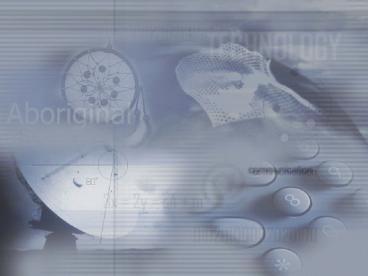Aboriginal Connectivity Statistics PowerPoint PPT Presentation
1 / 10
Title: Aboriginal Connectivity Statistics
1
(No Transcript)
2
Aboriginal Connectivity Statistics
- Purpose
- Initial purpose was to verify the existence of,
then track trends of the Aboriginal digital
divide.
- Other countries are tracking Aboriginal
connectivity issues
- Important to aggregate all connectivity
initiatives to present the most accurate picture
to policy makers
- Provide a source of information for communities
that are struggling to get online
- Address the need to track trends in connectivity
rather than capture a snapshot Internet
connectivity rates are a moving target.
- Create a coordinated centre to deal with the
difficulties of analysing connectivity in
Aboriginal communities - Population, counting, geographic challenges
- Seasonal populations
- Community definitions
3
Team/Interdepartmental/Stakeholder Sources
Report currently contains information from
Industry Canada Schoolnet, Community Access
Point sites, insight and dialogue with broadband
research group.
- Indian and Northern Affairs
- Survey of 720 Aboriginal communities with a 75
response rate - Population community data
Private Sector Telecom Service Improvement
plans filed with the CRTC and IPS dial in
locations
Statistics Canada Census data for community
demographics.
4
Difficulties Faced when collecting Information
- Community Definitions
A locality which is considered to be an Indian,
Inuit or Métis community (Indian reserve, Indian
settlement, Métis settlement, Inuit hamlet or
census sub-division with 25 percent or more
aboriginal population) having the following
attributes a name, distinct physical location
and territory, and aboriginal governance
structure, mandate and constituency
- Not all Band or community administration offices
are on reserve
- Survey Fatigue
- Connectivity status changes quicker than our
survey turnaround
- Change in community administrative personnel.
- Potential skewing of data because of inability
to contact some communities
5
General Findings
Community Access
- Over 85 of Aboriginal communities
- are connected to the Internet at the
- community level.
- Most communities access the
- Internet using dial-in modems
- 28 of dial-in users incur long
- distance telephone charges.
- Use of the Internet at the community
- administration office varies between
- Provinces and Territories
- Subscription to high speed Internet
- services at the community administration
- office are low but increasing.
6
General Findings
Household Access
- 89 of Aboriginal communities can
- have access to the Internet at the
- household level.
- 84 rely on modems for their
- connection
- 29 of dial-in users incur long
- distance telephone charges.
- Use of the High Speed Internet
- services varies between Provinces
- and Territories
- Availability of high-speed Internet
- services is directly correlated to
- community population.
7
CRTC High Cost Serving Areas Ruling
- In 1999 the CRTC established the following basic
service objective for local carriers which
included - Individual line local service with touch-tone
dialing, provided by a digital switch - capability to connect via low speed data
transmission to the Internet at local rates - other functionality such as call display etc
In keeping with ruling, phone companies have/are
submitting Service Improvement Plans (SIPs) which
describes, who, how much and why not (to
expensive, no demand, too few houses etc)
- Our analysis of the submitted
- SIPs indicates that
- 148 Aboriginal communities
- could benefit
- approximate investment of
- 41million dollars in
- telecommunications infrastructure
- more to come, someSIPs returned
- back from the CRTC to the phone
- company for more details
8
CRTC High Cost Serving Areas Ruling (cont)
Internet Access Assessment by Telephone Providers
- As illustrated there are 145 exchanges serving
Aboriginal communities that - currently do not have an Internet Service
Provider - 61 of these locations are served via satellite,
which makes toll free Internet - access very costly
- Remaining 71 include small communities and
locations served by older - technology.
- Equipment upgrades may solve the technical
issues but community size may - limit the commercial attractiveness for an ISP.
9
Issues to be address in the Future
- Re-survey Aboriginal communities that have
provided incomplete or no information.
- Continue to analyse Service Improvement Plans as
they are approved, and put into action
- Continue to track Federal and regional
connectivity initiatives.
- Integrate data on Health Canada telehealth
connectivity and remote sites project.
Next Steps
- Collect feedback on draft report and implement
recommendations - mailto connectivity_at_inac.gc.ca
- By April 30th launch of the Aboriginal
Connectivity Website (real-time results - Instant
results, graphics and statistics whenever a
community connectivity profile is updated)
- Forward completed report to the CRTC, Telcos,
Innovation/IC and other telecommunications policy
makers for their review and input
10
End

